Role of Macronutrients in Health
VerifiedAdded on 2023/01/11
|7
|2123
|77
AI Summary
This article discusses the roles of macronutrients in health, including their composition, biological functions, dietary sources, and daily intake. It also explores the factors contributing to excess and deficiencies, as well as the signs and symptoms of malnutrition. Understanding the importance of macronutrients is crucial for maintaining overall health.
Contribute Materials
Your contribution can guide someone’s learning journey. Share your
documents today.
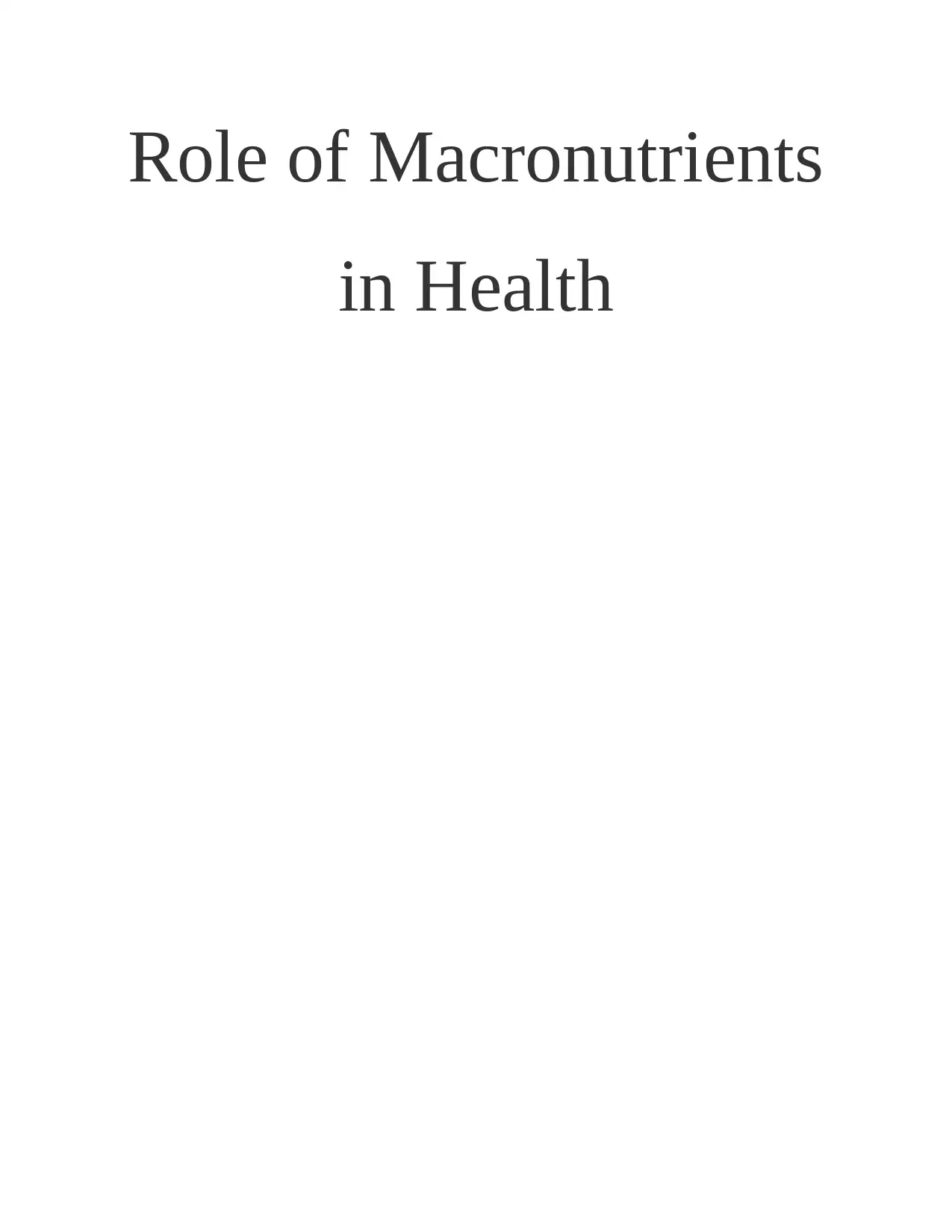
Role of Macronutrients
in Health
in Health
Secure Best Marks with AI Grader
Need help grading? Try our AI Grader for instant feedback on your assignments.
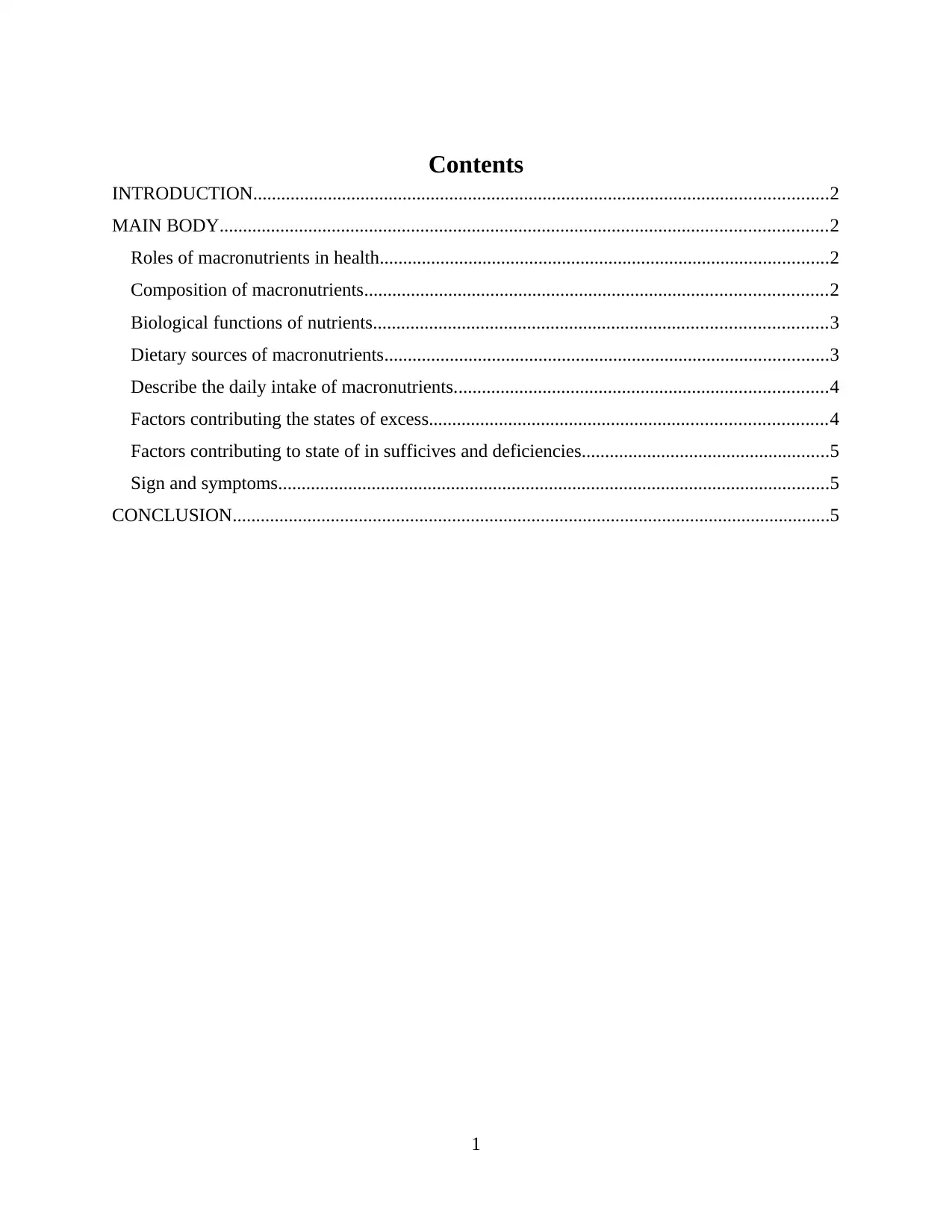
Contents
INTRODUCTION...........................................................................................................................2
MAIN BODY..................................................................................................................................2
Roles of macronutrients in health................................................................................................2
Composition of macronutrients...................................................................................................2
Biological functions of nutrients.................................................................................................3
Dietary sources of macronutrients...............................................................................................3
Describe the daily intake of macronutrients................................................................................4
Factors contributing the states of excess.....................................................................................4
Factors contributing to state of in sufficives and deficiencies.....................................................5
Sign and symptoms......................................................................................................................5
CONCLUSION................................................................................................................................5
1
INTRODUCTION...........................................................................................................................2
MAIN BODY..................................................................................................................................2
Roles of macronutrients in health................................................................................................2
Composition of macronutrients...................................................................................................2
Biological functions of nutrients.................................................................................................3
Dietary sources of macronutrients...............................................................................................3
Describe the daily intake of macronutrients................................................................................4
Factors contributing the states of excess.....................................................................................4
Factors contributing to state of in sufficives and deficiencies.....................................................5
Sign and symptoms......................................................................................................................5
CONCLUSION................................................................................................................................5
1
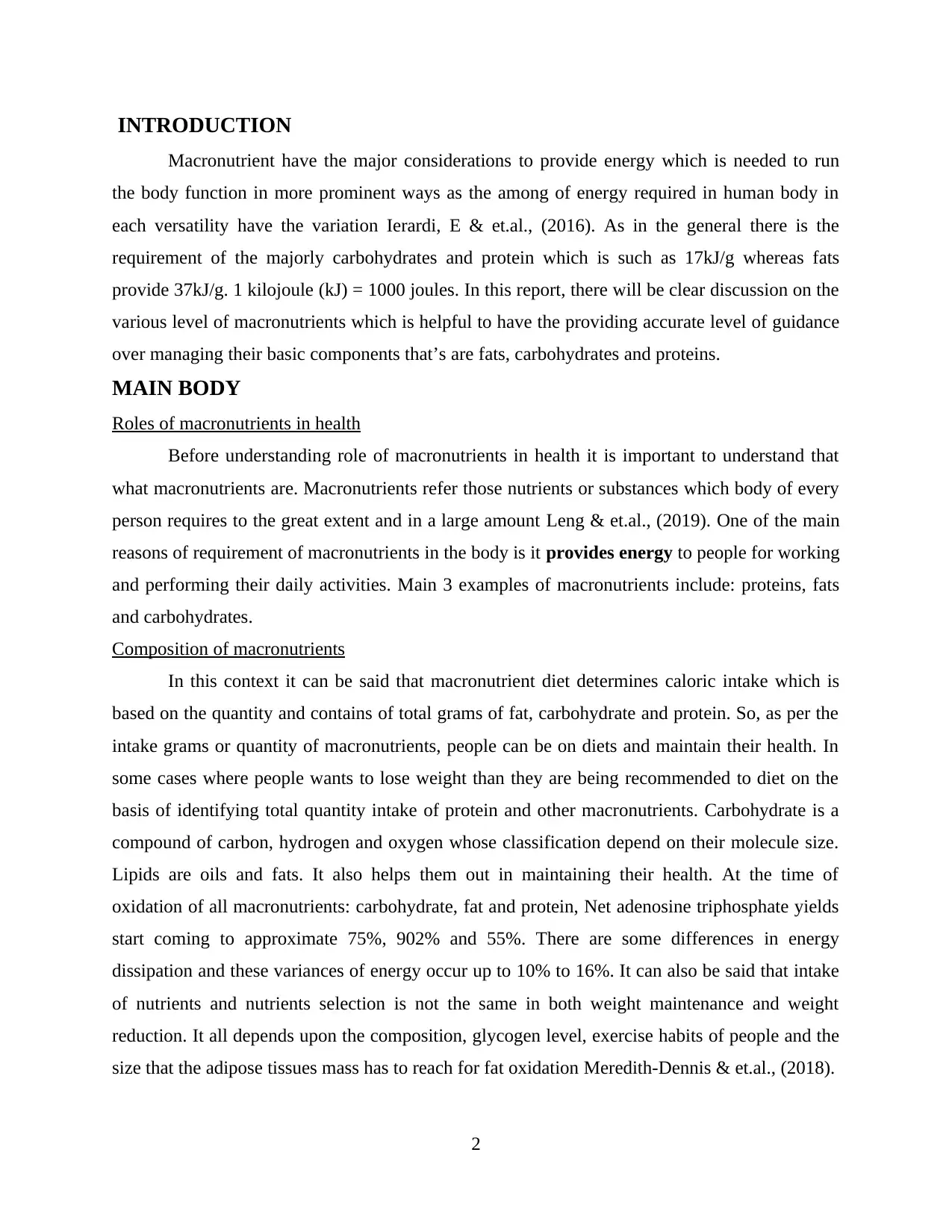
INTRODUCTION
Macronutrient have the major considerations to provide energy which is needed to run
the body function in more prominent ways as the among of energy required in human body in
each versatility have the variation Ierardi, E & et.al., (2016). As in the general there is the
requirement of the majorly carbohydrates and protein which is such as 17kJ/g whereas fats
provide 37kJ/g. 1 kilojoule (kJ) = 1000 joules. In this report, there will be clear discussion on the
various level of macronutrients which is helpful to have the providing accurate level of guidance
over managing their basic components that’s are fats, carbohydrates and proteins.
MAIN BODY
Roles of macronutrients in health
Before understanding role of macronutrients in health it is important to understand that
what macronutrients are. Macronutrients refer those nutrients or substances which body of every
person requires to the great extent and in a large amount Leng & et.al., (2019). One of the main
reasons of requirement of macronutrients in the body is it provides energy to people for working
and performing their daily activities. Main 3 examples of macronutrients include: proteins, fats
and carbohydrates.
Composition of macronutrients
In this context it can be said that macronutrient diet determines caloric intake which is
based on the quantity and contains of total grams of fat, carbohydrate and protein. So, as per the
intake grams or quantity of macronutrients, people can be on diets and maintain their health. In
some cases where people wants to lose weight than they are being recommended to diet on the
basis of identifying total quantity intake of protein and other macronutrients. Carbohydrate is a
compound of carbon, hydrogen and oxygen whose classification depend on their molecule size.
Lipids are oils and fats. It also helps them out in maintaining their health. At the time of
oxidation of all macronutrients: carbohydrate, fat and protein, Net adenosine triphosphate yields
start coming to approximate 75%, 902% and 55%. There are some differences in energy
dissipation and these variances of energy occur up to 10% to 16%. It can also be said that intake
of nutrients and nutrients selection is not the same in both weight maintenance and weight
reduction. It all depends upon the composition, glycogen level, exercise habits of people and the
size that the adipose tissues mass has to reach for fat oxidation Meredith-Dennis & et.al., (2018).
2
Macronutrient have the major considerations to provide energy which is needed to run
the body function in more prominent ways as the among of energy required in human body in
each versatility have the variation Ierardi, E & et.al., (2016). As in the general there is the
requirement of the majorly carbohydrates and protein which is such as 17kJ/g whereas fats
provide 37kJ/g. 1 kilojoule (kJ) = 1000 joules. In this report, there will be clear discussion on the
various level of macronutrients which is helpful to have the providing accurate level of guidance
over managing their basic components that’s are fats, carbohydrates and proteins.
MAIN BODY
Roles of macronutrients in health
Before understanding role of macronutrients in health it is important to understand that
what macronutrients are. Macronutrients refer those nutrients or substances which body of every
person requires to the great extent and in a large amount Leng & et.al., (2019). One of the main
reasons of requirement of macronutrients in the body is it provides energy to people for working
and performing their daily activities. Main 3 examples of macronutrients include: proteins, fats
and carbohydrates.
Composition of macronutrients
In this context it can be said that macronutrient diet determines caloric intake which is
based on the quantity and contains of total grams of fat, carbohydrate and protein. So, as per the
intake grams or quantity of macronutrients, people can be on diets and maintain their health. In
some cases where people wants to lose weight than they are being recommended to diet on the
basis of identifying total quantity intake of protein and other macronutrients. Carbohydrate is a
compound of carbon, hydrogen and oxygen whose classification depend on their molecule size.
Lipids are oils and fats. It also helps them out in maintaining their health. At the time of
oxidation of all macronutrients: carbohydrate, fat and protein, Net adenosine triphosphate yields
start coming to approximate 75%, 902% and 55%. There are some differences in energy
dissipation and these variances of energy occur up to 10% to 16%. It can also be said that intake
of nutrients and nutrients selection is not the same in both weight maintenance and weight
reduction. It all depends upon the composition, glycogen level, exercise habits of people and the
size that the adipose tissues mass has to reach for fat oxidation Meredith-Dennis & et.al., (2018).
2
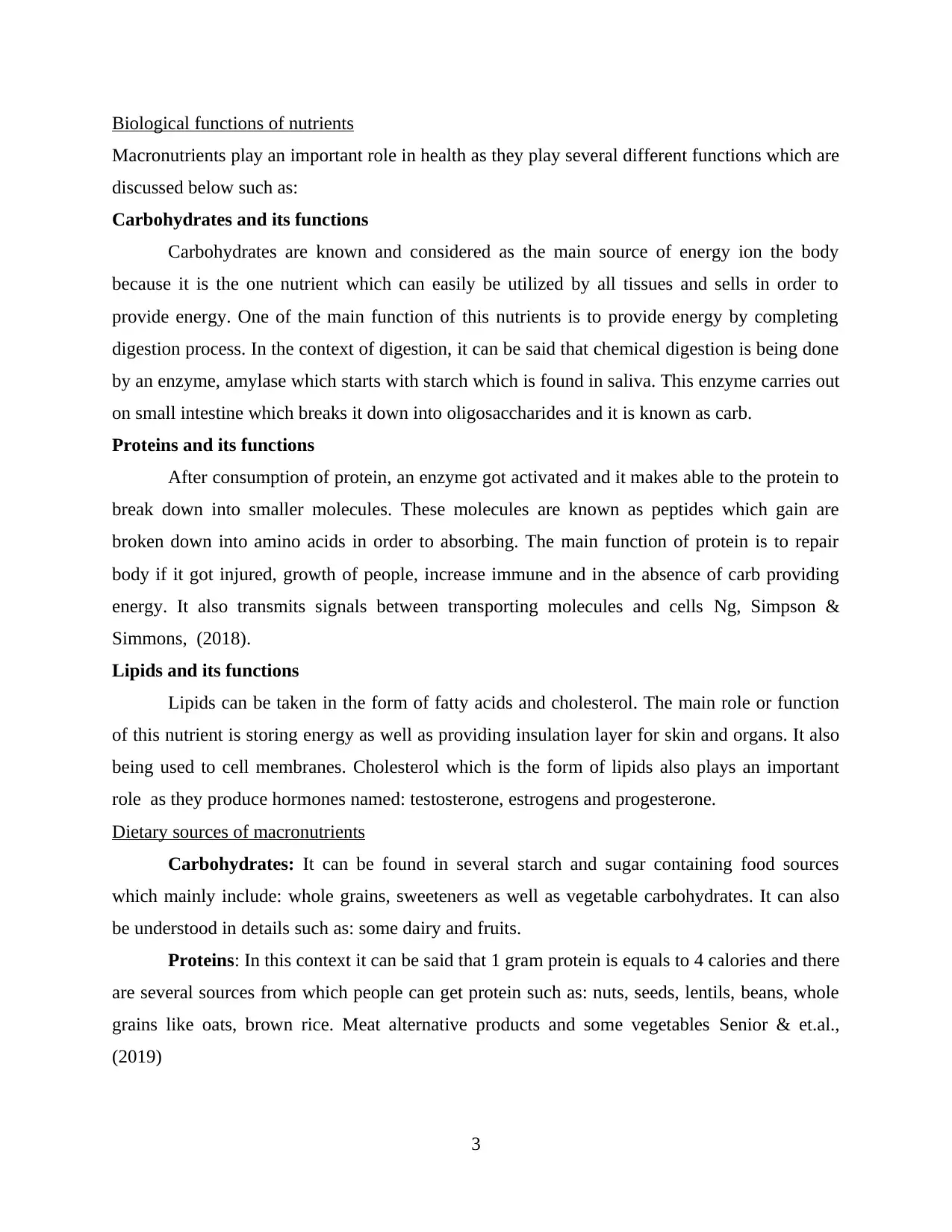
Biological functions of nutrients
Macronutrients play an important role in health as they play several different functions which are
discussed below such as:
Carbohydrates and its functions
Carbohydrates are known and considered as the main source of energy ion the body
because it is the one nutrient which can easily be utilized by all tissues and sells in order to
provide energy. One of the main function of this nutrients is to provide energy by completing
digestion process. In the context of digestion, it can be said that chemical digestion is being done
by an enzyme, amylase which starts with starch which is found in saliva. This enzyme carries out
on small intestine which breaks it down into oligosaccharides and it is known as carb.
Proteins and its functions
After consumption of protein, an enzyme got activated and it makes able to the protein to
break down into smaller molecules. These molecules are known as peptides which gain are
broken down into amino acids in order to absorbing. The main function of protein is to repair
body if it got injured, growth of people, increase immune and in the absence of carb providing
energy. It also transmits signals between transporting molecules and cells Ng, Simpson &
Simmons, (2018).
Lipids and its functions
Lipids can be taken in the form of fatty acids and cholesterol. The main role or function
of this nutrient is storing energy as well as providing insulation layer for skin and organs. It also
being used to cell membranes. Cholesterol which is the form of lipids also plays an important
role as they produce hormones named: testosterone, estrogens and progesterone.
Dietary sources of macronutrients
Carbohydrates: It can be found in several starch and sugar containing food sources
which mainly include: whole grains, sweeteners as well as vegetable carbohydrates. It can also
be understood in details such as: some dairy and fruits.
Proteins: In this context it can be said that 1 gram protein is equals to 4 calories and there
are several sources from which people can get protein such as: nuts, seeds, lentils, beans, whole
grains like oats, brown rice. Meat alternative products and some vegetables Senior & et.al.,
(2019)
3
Macronutrients play an important role in health as they play several different functions which are
discussed below such as:
Carbohydrates and its functions
Carbohydrates are known and considered as the main source of energy ion the body
because it is the one nutrient which can easily be utilized by all tissues and sells in order to
provide energy. One of the main function of this nutrients is to provide energy by completing
digestion process. In the context of digestion, it can be said that chemical digestion is being done
by an enzyme, amylase which starts with starch which is found in saliva. This enzyme carries out
on small intestine which breaks it down into oligosaccharides and it is known as carb.
Proteins and its functions
After consumption of protein, an enzyme got activated and it makes able to the protein to
break down into smaller molecules. These molecules are known as peptides which gain are
broken down into amino acids in order to absorbing. The main function of protein is to repair
body if it got injured, growth of people, increase immune and in the absence of carb providing
energy. It also transmits signals between transporting molecules and cells Ng, Simpson &
Simmons, (2018).
Lipids and its functions
Lipids can be taken in the form of fatty acids and cholesterol. The main role or function
of this nutrient is storing energy as well as providing insulation layer for skin and organs. It also
being used to cell membranes. Cholesterol which is the form of lipids also plays an important
role as they produce hormones named: testosterone, estrogens and progesterone.
Dietary sources of macronutrients
Carbohydrates: It can be found in several starch and sugar containing food sources
which mainly include: whole grains, sweeteners as well as vegetable carbohydrates. It can also
be understood in details such as: some dairy and fruits.
Proteins: In this context it can be said that 1 gram protein is equals to 4 calories and there
are several sources from which people can get protein such as: nuts, seeds, lentils, beans, whole
grains like oats, brown rice. Meat alternative products and some vegetables Senior & et.al.,
(2019)
3
Secure Best Marks with AI Grader
Need help grading? Try our AI Grader for instant feedback on your assignments.

Lipids: It refers oil and fats which people can take from oils, dried beans, peas, peanuts, animal
proteins etc.
So, from the above, it can be said that all macronutrients play a vital role in teh body of
protecting people, maintaining health and growth.
Describe the daily intake of macronutrients.
Macronutrient are made of three important factor that’s is fats, carbohydrates and proteins. Ro
have the description the carbohydrates provide energy to have the contribution in taste and
texture of food and considered essentials assimilation and digestions of other foods. There is the
formation of two different carbohydrates such as Simple carbohydrates: monosaccharides
(deoxyribose, galactose, glucose, ribose, fructose) and disaccharides (sucrose, maltose, lactose).
Complex carbohydrates: Polysaccharides (fibre, glycogen, starch). So, eating there enough level
of fibre will have preventative form hearts diseases which maid aid in the weights loss and
improve the appetite control.
Moving next to the fats or lipids which is the insulator of body which is carried more level of
vitamin which have belonging fat soluble category Anderson, L & et.al. ,(2017). As per the
recommendation 10% is the maximum level of saturated fats, 200 mg od maximum level of
cholesterol.
As las in the case of protein is considered to be sources of energy helpful in growth and
developments and maintain the acid base equilibrium. As per the recommendation, there is
requirement of 1.0 g/kg of body weight of protein as a macronutrient. In addition to that’s 15
grams/kg body weight per day, in addition, must be taken during in latter half of pregnancy.
Factors contributing the states of excess.
Human body have evolving to have hang-up in their fuel because due to starvation is the part of
life in early humans. It there once of week when the body have the hold on the calories as it can
hedge against starvations. The factor has more level of carelessness and more starvation which
will major contribution in high-carbohydrate diet makes them put on weight.
As the result of the excessive nutrient have resulted in the gaining of more level of weight gains
as the energy needs as the excess carbohydrates can convert to fatty acids for storage in your
adipose tissue Frediani, J.K & et.al., (2016). In addition to that’s there is increase of nutrients as
the fat-soluble vitamins are especially probes to have adverse effects. In addition, o that’s their
4
proteins etc.
So, from the above, it can be said that all macronutrients play a vital role in teh body of
protecting people, maintaining health and growth.
Describe the daily intake of macronutrients.
Macronutrient are made of three important factor that’s is fats, carbohydrates and proteins. Ro
have the description the carbohydrates provide energy to have the contribution in taste and
texture of food and considered essentials assimilation and digestions of other foods. There is the
formation of two different carbohydrates such as Simple carbohydrates: monosaccharides
(deoxyribose, galactose, glucose, ribose, fructose) and disaccharides (sucrose, maltose, lactose).
Complex carbohydrates: Polysaccharides (fibre, glycogen, starch). So, eating there enough level
of fibre will have preventative form hearts diseases which maid aid in the weights loss and
improve the appetite control.
Moving next to the fats or lipids which is the insulator of body which is carried more level of
vitamin which have belonging fat soluble category Anderson, L & et.al. ,(2017). As per the
recommendation 10% is the maximum level of saturated fats, 200 mg od maximum level of
cholesterol.
As las in the case of protein is considered to be sources of energy helpful in growth and
developments and maintain the acid base equilibrium. As per the recommendation, there is
requirement of 1.0 g/kg of body weight of protein as a macronutrient. In addition to that’s 15
grams/kg body weight per day, in addition, must be taken during in latter half of pregnancy.
Factors contributing the states of excess.
Human body have evolving to have hang-up in their fuel because due to starvation is the part of
life in early humans. It there once of week when the body have the hold on the calories as it can
hedge against starvations. The factor has more level of carelessness and more starvation which
will major contribution in high-carbohydrate diet makes them put on weight.
As the result of the excessive nutrient have resulted in the gaining of more level of weight gains
as the energy needs as the excess carbohydrates can convert to fatty acids for storage in your
adipose tissue Frediani, J.K & et.al., (2016). In addition to that’s there is increase of nutrients as
the fat-soluble vitamins are especially probes to have adverse effects. In addition, o that’s their
4
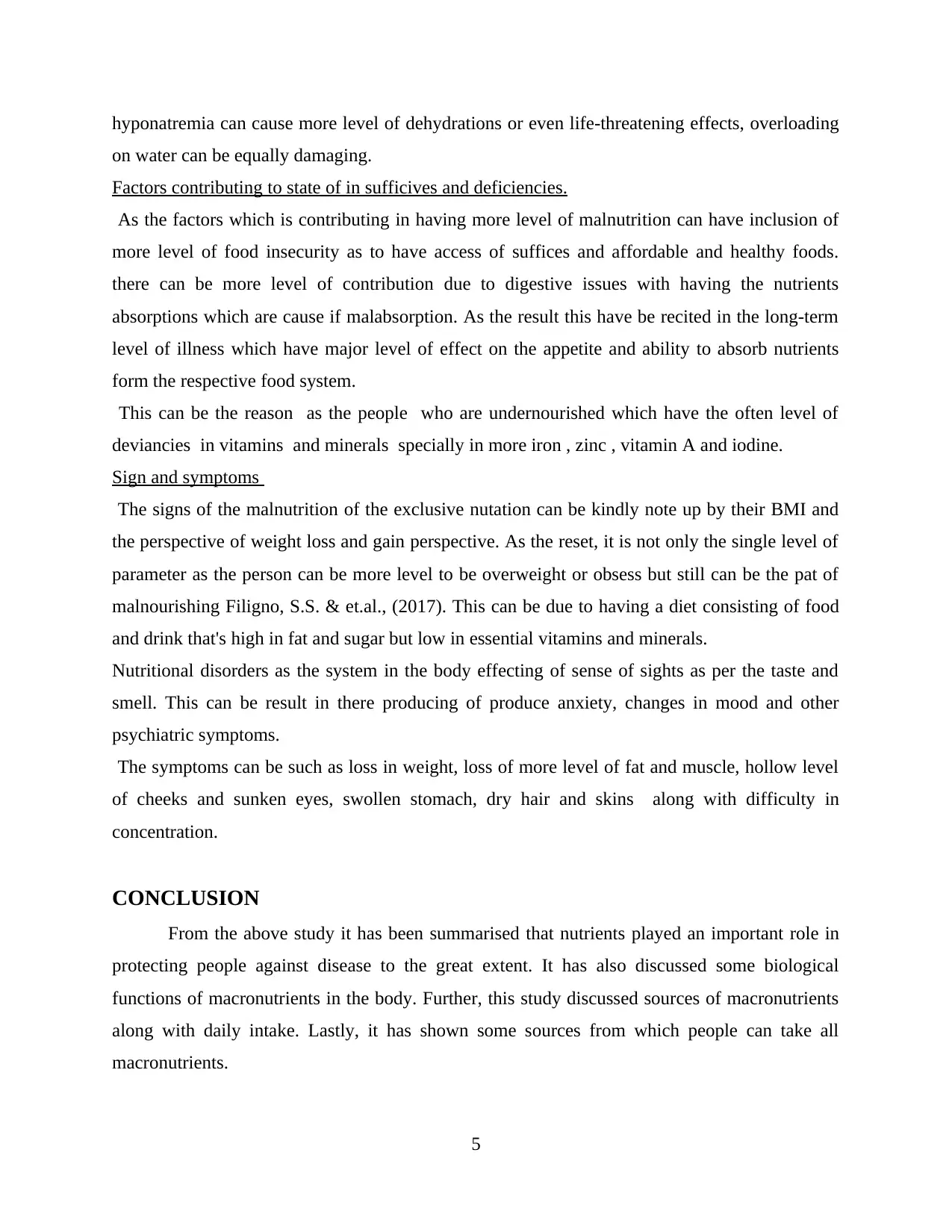
hyponatremia can cause more level of dehydrations or even life-threatening effects, overloading
on water can be equally damaging.
Factors contributing to state of in sufficives and deficiencies.
As the factors which is contributing in having more level of malnutrition can have inclusion of
more level of food insecurity as to have access of suffices and affordable and healthy foods.
there can be more level of contribution due to digestive issues with having the nutrients
absorptions which are cause if malabsorption. As the result this have be recited in the long-term
level of illness which have major level of effect on the appetite and ability to absorb nutrients
form the respective food system.
This can be the reason as the people who are undernourished which have the often level of
deviancies in vitamins and minerals specially in more iron , zinc , vitamin A and iodine.
Sign and symptoms
The signs of the malnutrition of the exclusive nutation can be kindly note up by their BMI and
the perspective of weight loss and gain perspective. As the reset, it is not only the single level of
parameter as the person can be more level to be overweight or obsess but still can be the pat of
malnourishing Filigno, S.S. & et.al., (2017). This can be due to having a diet consisting of food
and drink that's high in fat and sugar but low in essential vitamins and minerals.
Nutritional disorders as the system in the body effecting of sense of sights as per the taste and
smell. This can be result in there producing of produce anxiety, changes in mood and other
psychiatric symptoms.
The symptoms can be such as loss in weight, loss of more level of fat and muscle, hollow level
of cheeks and sunken eyes, swollen stomach, dry hair and skins along with difficulty in
concentration.
CONCLUSION
From the above study it has been summarised that nutrients played an important role in
protecting people against disease to the great extent. It has also discussed some biological
functions of macronutrients in the body. Further, this study discussed sources of macronutrients
along with daily intake. Lastly, it has shown some sources from which people can take all
macronutrients.
5
on water can be equally damaging.
Factors contributing to state of in sufficives and deficiencies.
As the factors which is contributing in having more level of malnutrition can have inclusion of
more level of food insecurity as to have access of suffices and affordable and healthy foods.
there can be more level of contribution due to digestive issues with having the nutrients
absorptions which are cause if malabsorption. As the result this have be recited in the long-term
level of illness which have major level of effect on the appetite and ability to absorb nutrients
form the respective food system.
This can be the reason as the people who are undernourished which have the often level of
deviancies in vitamins and minerals specially in more iron , zinc , vitamin A and iodine.
Sign and symptoms
The signs of the malnutrition of the exclusive nutation can be kindly note up by their BMI and
the perspective of weight loss and gain perspective. As the reset, it is not only the single level of
parameter as the person can be more level to be overweight or obsess but still can be the pat of
malnourishing Filigno, S.S. & et.al., (2017). This can be due to having a diet consisting of food
and drink that's high in fat and sugar but low in essential vitamins and minerals.
Nutritional disorders as the system in the body effecting of sense of sights as per the taste and
smell. This can be result in there producing of produce anxiety, changes in mood and other
psychiatric symptoms.
The symptoms can be such as loss in weight, loss of more level of fat and muscle, hollow level
of cheeks and sunken eyes, swollen stomach, dry hair and skins along with difficulty in
concentration.
CONCLUSION
From the above study it has been summarised that nutrients played an important role in
protecting people against disease to the great extent. It has also discussed some biological
functions of macronutrients in the body. Further, this study discussed sources of macronutrients
along with daily intake. Lastly, it has shown some sources from which people can take all
macronutrients.
5
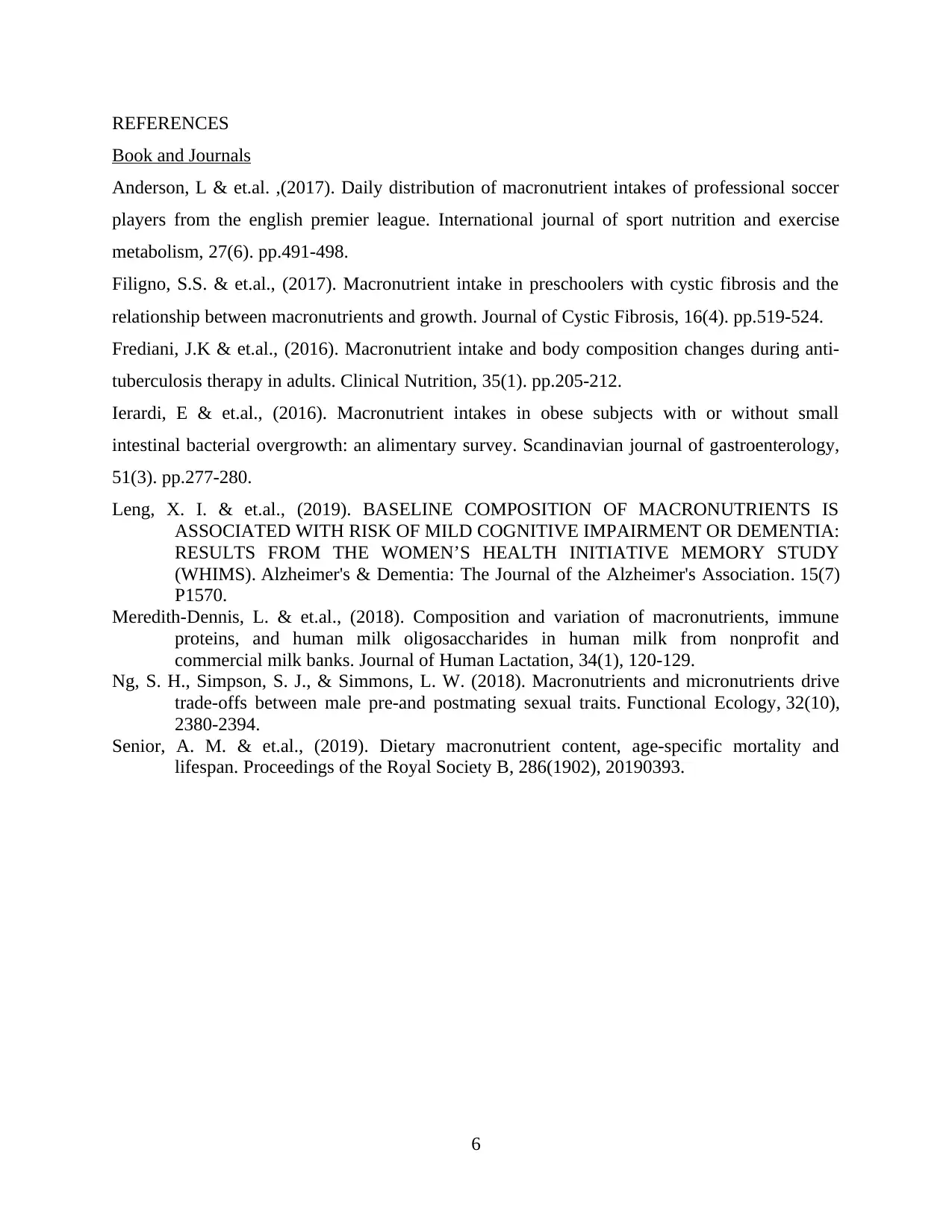
REFERENCES
Book and Journals
Anderson, L & et.al. ,(2017). Daily distribution of macronutrient intakes of professional soccer
players from the english premier league. International journal of sport nutrition and exercise
metabolism, 27(6). pp.491-498.
Filigno, S.S. & et.al., (2017). Macronutrient intake in preschoolers with cystic fibrosis and the
relationship between macronutrients and growth. Journal of Cystic Fibrosis, 16(4). pp.519-524.
Frediani, J.K & et.al., (2016). Macronutrient intake and body composition changes during anti-
tuberculosis therapy in adults. Clinical Nutrition, 35(1). pp.205-212.
Ierardi, E & et.al., (2016). Macronutrient intakes in obese subjects with or without small
intestinal bacterial overgrowth: an alimentary survey. Scandinavian journal of gastroenterology,
51(3). pp.277-280.
Leng, X. I. & et.al., (2019). BASELINE COMPOSITION OF MACRONUTRIENTS IS
ASSOCIATED WITH RISK OF MILD COGNITIVE IMPAIRMENT OR DEMENTIA:
RESULTS FROM THE WOMEN’S HEALTH INITIATIVE MEMORY STUDY
(WHIMS). Alzheimer's & Dementia: The Journal of the Alzheimer's Association. 15(7)
P1570.
Meredith-Dennis, L. & et.al., (2018). Composition and variation of macronutrients, immune
proteins, and human milk oligosaccharides in human milk from nonprofit and
commercial milk banks. Journal of Human Lactation, 34(1), 120-129.
Ng, S. H., Simpson, S. J., & Simmons, L. W. (2018). Macronutrients and micronutrients drive
trade‐offs between male pre‐and postmating sexual traits. Functional Ecology, 32(10),
2380-2394.
Senior, A. M. & et.al., (2019). Dietary macronutrient content, age-specific mortality and
lifespan. Proceedings of the Royal Society B, 286(1902), 20190393.
6
Book and Journals
Anderson, L & et.al. ,(2017). Daily distribution of macronutrient intakes of professional soccer
players from the english premier league. International journal of sport nutrition and exercise
metabolism, 27(6). pp.491-498.
Filigno, S.S. & et.al., (2017). Macronutrient intake in preschoolers with cystic fibrosis and the
relationship between macronutrients and growth. Journal of Cystic Fibrosis, 16(4). pp.519-524.
Frediani, J.K & et.al., (2016). Macronutrient intake and body composition changes during anti-
tuberculosis therapy in adults. Clinical Nutrition, 35(1). pp.205-212.
Ierardi, E & et.al., (2016). Macronutrient intakes in obese subjects with or without small
intestinal bacterial overgrowth: an alimentary survey. Scandinavian journal of gastroenterology,
51(3). pp.277-280.
Leng, X. I. & et.al., (2019). BASELINE COMPOSITION OF MACRONUTRIENTS IS
ASSOCIATED WITH RISK OF MILD COGNITIVE IMPAIRMENT OR DEMENTIA:
RESULTS FROM THE WOMEN’S HEALTH INITIATIVE MEMORY STUDY
(WHIMS). Alzheimer's & Dementia: The Journal of the Alzheimer's Association. 15(7)
P1570.
Meredith-Dennis, L. & et.al., (2018). Composition and variation of macronutrients, immune
proteins, and human milk oligosaccharides in human milk from nonprofit and
commercial milk banks. Journal of Human Lactation, 34(1), 120-129.
Ng, S. H., Simpson, S. J., & Simmons, L. W. (2018). Macronutrients and micronutrients drive
trade‐offs between male pre‐and postmating sexual traits. Functional Ecology, 32(10),
2380-2394.
Senior, A. M. & et.al., (2019). Dietary macronutrient content, age-specific mortality and
lifespan. Proceedings of the Royal Society B, 286(1902), 20190393.
6
1 out of 7
Related Documents
Your All-in-One AI-Powered Toolkit for Academic Success.
+13062052269
info@desklib.com
Available 24*7 on WhatsApp / Email
![[object Object]](/_next/static/media/star-bottom.7253800d.svg)
Unlock your academic potential
© 2024 | Zucol Services PVT LTD | All rights reserved.





